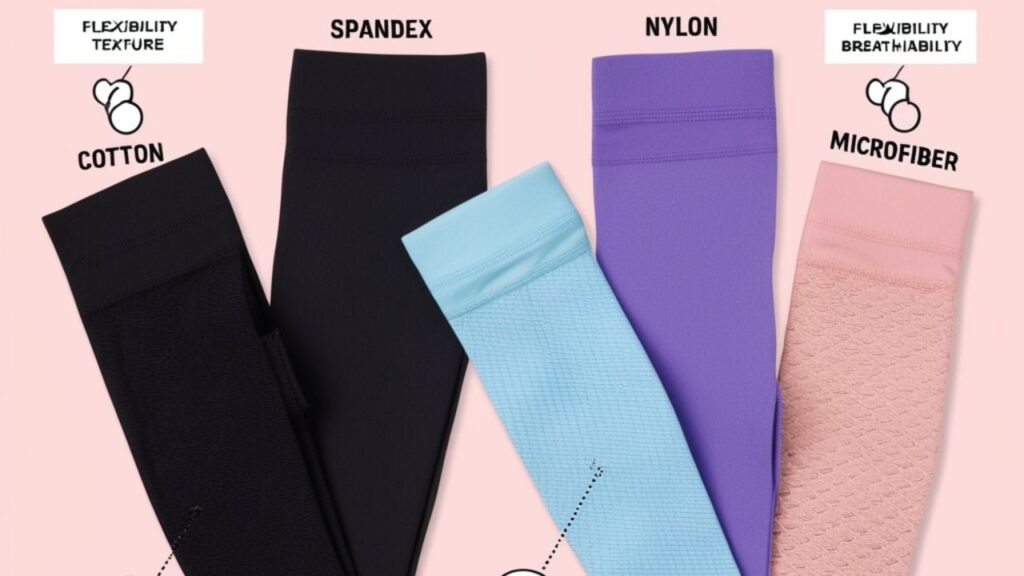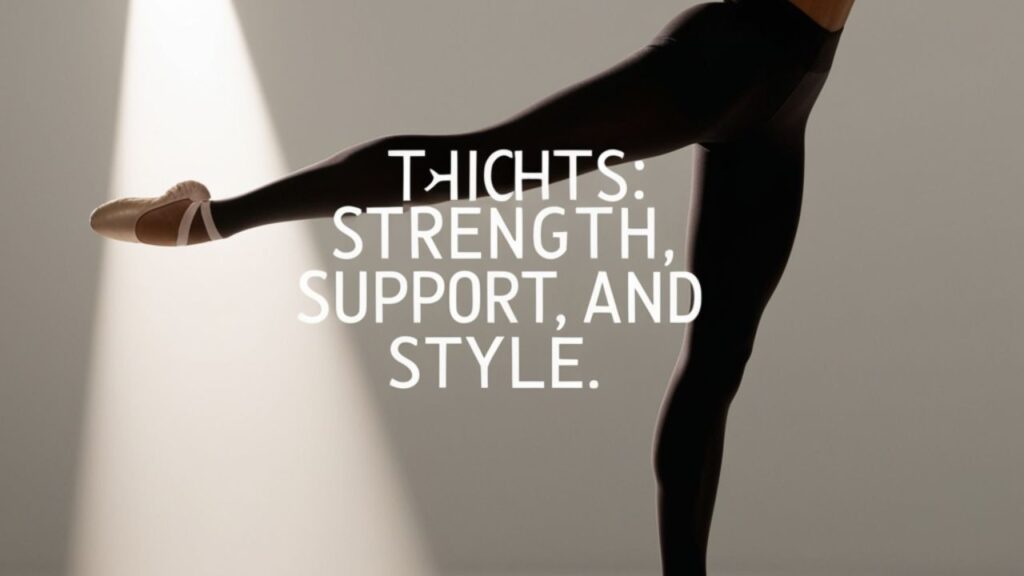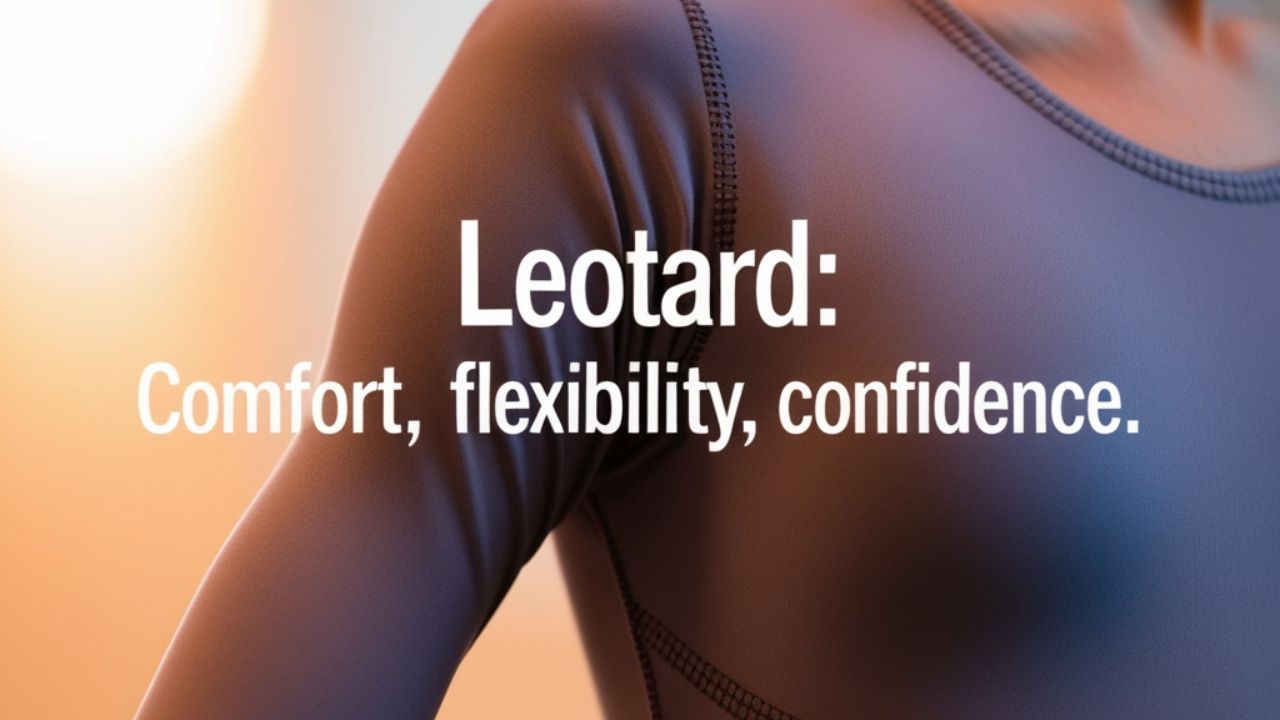A leotard is a one-piece outfit that covers the body from the shoulders to the hips. It fits tightly and helps dancers move easily. This clothing gives comfort, support, and freedom during dance practice or stage shows. It keeps the body warm and flexible.
Tights are close-fitting garments worn on the legs, usually from the waist down to the feet. They help keep muscles warm and make movements smoother. Many dancers wear them with leotards to stay covered and comfortable while performing different steps.
The main difference lies in coverage and purpose. A leotard supports the upper body, while tights protect and shape the legs. Together, they create a neat, graceful look and help dancers perform better with balance, confidence, and control.
What Is a Leotard?
A leotard is a soft, stretchy outfit made from fabric like cotton or spandex. It fits closely to the body and helps dancers, gymnasts, and performers move freely. It covers the chest and hips, allowing easy movement without extra fabric getting in the way.
This garment comes in many styles such as sleeveless, short-sleeve, or long-sleeve. Some have open backs or mesh designs for comfort and style. A leotard helps keep the body warm, supports posture, and gives a neat look during dance or gymnastic practice.
Styles and Variations
Leotards come in many styles that suit different activities. Some have no sleeves, while others have short or long sleeves. Dancers use high-cut designs for smooth leg movement, and gymnasts prefer snug fits that stay in place during flips or turns.
Different variations include open-back, closed-back, or mesh panels that allow airflow. Some designs have shiny fabric or soft colors for stage use. Each type focuses on comfort, flexibility, and neat appearance, helping performers move easily while looking smart and confident.
- Sleeve Options: Some leotards come sleeveless for easy arm movement, while others have short or long sleeves to keep the body warm and covered. Each type supports comfort and flexibility during dance or sports.
- Design Choices: Different styles include open-back, closed-back, or mesh designs. These allow air to pass through and give a stylish look for stage performances or daily practice.
- Cut and Fit: High-cut leglines suit gymnastics, while classic cuts fit ballet. Each variation is made to match the dancer’s need for comfort, stretch, and freedom of movement.
What Are Tights?
Tights are thin, stretchy clothes worn on the legs from the waist to the feet. They fit closely and keep the legs warm during dancing or exercise. Many dancers wear them for smooth movement and to make their legs look neat on stage.
Different types include footed, footless, and stirrup styles. Some are thick for warmth, while others are light and soft for easy stretching. The fabric is usually nylon or spandex, helping the body stay flexible and comfortable during practice or performance.
Common Types
- Footed Style: These tights cover the legs and feet completely. They are mostly used in ballet to create a smooth line from waist to toe and keep the legs warm during practice or shows.
- Footless Style: This type ends at the ankle, giving freedom for barefoot dancing or workouts. These tights are often worn in modern dance and fitness classes for comfort and flexibility.
- Stirrup Style: These tights have a band under the arch of the foot, keeping them in place while leaving the heel and toes free. They’re perfect for gymnastics, skating, and other active movements.
Leotards: Who Wears Them and Why?

Leotards shine in settings demanding full mobility and precision.
Primary Users
- Ballet Dancers: They wear leotards for easy body movement and perfect posture. The snug fit helps them practice balance, grace, and flexibility while keeping a clean and professional look on stage.
- Gymnasts: They use leotards for safe flips, jumps, and routines. The stretchy fabric allows freedom to move without extra folds or slipping, giving comfort and support during training or competition.
- Figure Skaters: They wear fitted leotards under costumes to stay warm and stylish. The smooth material helps them glide easily and perform spins and turns with confidence on the ice.
See also Pajamas vs Pyjamas: The Real Spelling Difference
Tights: Who Wears Them and Why?
Tights appear in both performance art and everyday wardrobes.
Who Wears Tights?
Tights are worn by dancers, athletes, and stage performers. Ballet students wear them to keep their legs warm and to move easily. Skaters and gymnasts also use them for a smooth look and to protect their legs during long hours of practice.
People wear tights for many reasons. Actors use them in plays for costumes, and athletes wear them for comfort and muscle support. They help with movement, reduce tiredness, and make the body look neat and well-shaped during performance or training.
- Ballet Performers: They wear tights to keep their legs warm and muscles flexible. The smooth fabric helps create a neat look and supports graceful movement during practice and performances.
- Athletes: Many sports players use tights for comfort and support. The snug fit improves blood flow, keeps muscles strong, and reduces tiredness during running, skating, or gymnastics.
- Actors and Dancers: Stage performers wear tights as part of their costumes. They give a polished look, add warmth under stage lights, and help performers move freely in long shows or rehearsals.
Key Material and Construction Differences
Comparing leotard vs tights reveals distinct design strategies rooted in use-case demands.
Fabric Composition Table
| Aspect | Leotards | Tights |
| Primary fabrics | Cotton blends, Lycra, spandex | Nylon, spandex, microfiber, wool blends |
| Stretch mechanics | 4-way stretch, body compaction | 2–4 way stretch, leg compression |
| Durability factors | Reinforced seams, gussets | Denier resistance, moisture wicking |
| Support & lining | Built-in bras, crotch lining | None or light foot support |
Construction Features
A leotard is made with smooth seams and stretchy fabric that allows free movement. It often has lining inside for comfort and modesty. The leg openings stay firm, and the stitches are strong to stop tearing during dance or gymnastic routines.
Tights are designed with flat seams and soft waistbands for comfort. Some have reinforced toes to prevent holes and to last longer. The fabric stretches in all directions, giving support to the legs and helping performers move easily and safely on stage.
Activities Using Leotards
- Ballet Practice: Dancers wear leotards to move easily and keep the body in perfect form. The tight fit helps show posture, making it easier for teachers to correct movements and guide proper technique.
- Gymnastics Training: Athletes use leotards for flips, rolls, and balance routines. The smooth fabric prevents slipping and keeps the outfit secure, giving confidence and safety during every performance.
- Aerial Arts: Performers wear leotards while doing rope, hoop, or silk acts. The fitted design avoids loose edges that could catch equipment and helps the body stay flexible and protected in the air.
Real-World Example
“During my first gymnastics meet, I realized a leotard’s snug fit gave me confidence – it moved with… never against me.” – Coach Malina Torres
Activities Using Tights
- Ballet Classes: Dancers wear tights for smooth leg movement and a neat look. They help keep muscles warm and prevent strain during long hours of stretching, jumping, and turning.
- Ice Skating: Skaters use tights under their costumes for warmth and comfort. The soft, stretchy fabric allows them to glide easily and perform spins without feeling restricted.
- Theater Performances: Actors wear tights as part of stage outfits to match costumes and create a polished look. They offer coverage, flexibility, and comfort during long rehearsals or live shows.
Comparative Analysis: Design Differences

While the leotard cares for your upper body, tights manage the legs. One-piece vs. two-piece creates separate fit considerations.
Design Table
| Feature | Leotard | Tights |
| Coverage area | Torso, arms optional | Waist to feet |
| Closure style | Pull-on, sometimes snaps | Elastic waistband pull-on |
| Embellishments | Mesh, rhinestones, cutouts | Dies, matte/gloss finished, textured |
| Aesthetic shape | Clean lines, torso sculpting | Leg-enhancing compression |
Flexibility and Fit
A leotard fits closely to the body and stretches easily in every direction. It moves with the dancer, helping the body bend, twist, and jump without discomfort. The right size keeps the outfit firm but not tight, giving comfort during long practice hours.
Tights fit smoothly along the legs and allow full motion. Their soft, elastic fabric helps muscles stay warm and flexible. A good fit avoids wrinkles or slipping and supports balance and grace, making every dance move look neat and controlled.
Durability and Maintenance
Care Tips
- Gentle Washing: Wash leotards and tights in cold water using mild soap. Avoid strong detergents that can damage the elastic fibers and make the fabric lose its stretch or color.
- Air Drying: Always dry dancewear flat or hang it away from direct sunlight. Using a dryer can weaken the material and reduce its softness and flexibility over time.
- Proper Storage: Fold or hang leotards and tights neatly after use. Keep them in a clean, dry place to avoid wrinkles, stretching, or snagging from sharp objects or zippers.
Lifespan
- Regular Use: A leotard used often for dance or gymnastics usually lasts about one year. Frequent washing and stretching can slowly reduce its elasticity and color brightness.
- Performance Wear: High-quality tights used in daily training may last several months. Thicker fabric or higher denier materials stay strong longer and resist small tears or holes.
- Occasional Use: Dancewear worn less often, such as for shows or recitals, can last more than two years. Proper care, gentle washing, and safe storage help extend the lifespan of both garments.
Comfort, Performance & Aesthetic
Comfort Factors
A leotard keeps the body comfortable by using soft, breathable fabric that moves easily. It fits well without rubbing the skin and allows air to pass through. The smooth seams and light stretch help dancers feel relaxed during long rehearsals.
Tights give warmth and protect the legs from friction. Their flexible fabric supports muscles and prevents stiffness. The snug feel improves movement while keeping the body steady. Good quality material makes them gentle on the skin and easy to wear for many hours.
Aesthetic Appeal
A leotard shapes posture; tights define leg tone. Combined, they produce a sleek, coordinated ensemble ideal for stage or class.
See also Santa Clause vs Santa Claus: What’s the Real Difference?
Practical Buying Considerations
Selecting the right piece means considering activity, temperature, body type, and aesthetics.
Choosing a Leotard
- Activity Type: Pick a leotard that matches your activity. Ballet needs classic styles for movement, while gymnastics requires snug fits for safety during flips and jumps.
- Design and Comfort: Choose a style that feels good on your body. Options like sleeveless, short-sleeve, or long-sleeve allow comfort while keeping a clean and smart look.
- Support and Fabric: Look for soft, stretchy material like spandex or cotton blends. Some leotards include built-in support or lining to provide comfort and confidence during practice or performance.
Choosing Tights
- Fabric Strength: Select tights made from durable materials like nylon or spandex. These fabrics stretch easily, feel soft on the skin, and last longer even with daily use or frequent washing.
- Style and Purpose: Choose footed, footless, or stirrup styles based on your activity. Footed types suit ballet, while footless or stirrup designs work best for modern dance or fitness routines.
- Denier and Fit: Pick tights with the right thickness, usually between 40 and 80 denier for dancers. Ensure they fit snugly but not too tight, allowing smooth leg movement and all-day comfort.
Size Tips
Check brand charts; try before you buy for perfect leg fit and coverage.
Quality Over Price
FeatureGym leotards ($35–60) offer better durability. High-denier tights (70–120 denier) resist runs and remain opaque longer.
Common Myths and Misuse
- Not Interchangeable: Many people think leotards and tights are the same, but they serve different purposes. A leotard supports the upper body, while tights cover and protect the legs during dance or sports.
- Confusion with Other Wear: Some mix up tights with leggings or pantyhose. Leggings are thicker and used casually, while pantyhose are very thin and made for fashion, not for dancing or training.
- Wrong Usage: Wearing low-quality dancewear can cause discomfort or limit movement. Always choose proper fabric and fit for your activity to stay safe, comfortable, and confident while performing.
Real-Life Testimonials and Use Cases
Ballet Instructor:
“Tights keep my student legs warm and smooth, but the leotard is the anchor for posture.”
Gymnast Parent:
“When my daughter switched to a compression lycra leotard, she updated form and confidence.”
Dancewear Brand Leader:
“One-piece leotards increase mobility; high-denier tights reduce stage glare.”
Final Thoughts:
A leotard and tights work together to help dancers move with freedom and style. Each piece has its own purpose, giving comfort, shape, and support. They help the body stay warm and ready for smooth and confident movement during every performance.
Both garments are important for dance, sports, and stage shows. Their soft stretch and neat fit allow easy motion and balance. Wearing good-quality fabric keeps the body relaxed and helps performers focus on their steps with comfort and grace.
To Sum It Up:
A leotard covers the upper body and helps with balance, strength, and clean posture. It is light, smooth, and made for free movement. Dancers and gymnasts use it to stay flexible and confident while performing different moves on stage or during practice.
Tights cover the legs and provide warmth and support. They help the body stay comfortable and ready for action. When worn together, both garments create a neat look and help every performer move gracefully with comfort and full control.
| Consideration | Leotard | Tights |
| Covers | Torso (and sometimes arms) | Legs (waist to toe or ankle) |
| Best For | Dance, gymnastics, skating, fitness | Ballet, sports, fashion, compression |
| Fit | One-piece, snug on upper body | Tight-fitting legwear |
| Common Fabrics | Spandex, Lycra, cotton blends | Nylon, microfiber, spandex |
| Key Benefit | Freedom of motion + posture support | Compression + warmth + coverage |
FAQs
What is the difference between tights and leotard?
Tights cover the legs; a leotard covers the torso, leaving legs free, often worn together for dance or gymnastics.
Why do dancers wear tights over leotard?
It provides a smoother look, comfort, and easier access for costume changes or rehearsals.
Were tights ever called leotards?
No, they’re different garments; tights are legwear, while leotards cover the body’s upper part.
Why do dancers wear tights over leotard reddit?
According to Reddit users, it’s for style, convenience, warmth, and to meet studio or performance dress codes.

Join Bibcia on a journey to master English grammar. Discover easy lessons, writing tips, and practical examples designed to make learning grammar simple and effective.










